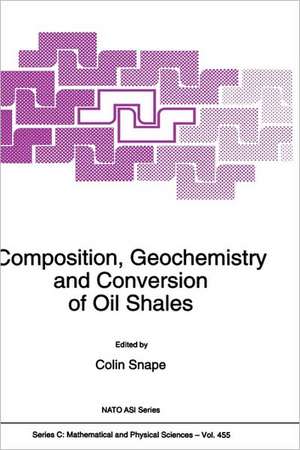Composition, Geochemistry and Conversion of Oil Shales: Nato Science Series C:, cartea 455
Editat de C.E. Snapeen Limba Engleză Hardback – 31 ian 1995
| Toate formatele și edițiile | Preț | Express |
|---|---|---|
| Paperback (1) | 1826.23 lei 6-8 săpt. | |
| SPRINGER NETHERLANDS – 26 oct 2012 | 1826.23 lei 6-8 săpt. | |
| Hardback (1) | 1832.53 lei 6-8 săpt. | |
| SPRINGER NETHERLANDS – 31 ian 1995 | 1832.53 lei 6-8 săpt. |
Din seria Nato Science Series C:
- 24%
 Preț: 797.69 lei
Preț: 797.69 lei - 18%
 Preț: 957.62 lei
Preț: 957.62 lei - 18%
 Preț: 957.13 lei
Preț: 957.13 lei - 18%
 Preț: 1227.52 lei
Preț: 1227.52 lei -
 Preț: 396.40 lei
Preț: 396.40 lei -
 Preț: 403.75 lei
Preț: 403.75 lei - 18%
 Preț: 1239.37 lei
Preț: 1239.37 lei - 18%
 Preț: 1236.51 lei
Preț: 1236.51 lei - 18%
 Preț: 1231.78 lei
Preț: 1231.78 lei - 18%
 Preț: 1229.10 lei
Preț: 1229.10 lei - 18%
 Preț: 1835.21 lei
Preț: 1835.21 lei - 24%
 Preț: 1076.39 lei
Preț: 1076.39 lei -
 Preț: 390.46 lei
Preț: 390.46 lei -
 Preț: 369.63 lei
Preț: 369.63 lei - 18%
 Preț: 1232.41 lei
Preț: 1232.41 lei -
 Preț: 394.51 lei
Preț: 394.51 lei - 18%
 Preț: 1226.24 lei
Preț: 1226.24 lei - 18%
 Preț: 1845.80 lei
Preț: 1845.80 lei -
 Preț: 399.88 lei
Preț: 399.88 lei -
 Preț: 384.28 lei
Preț: 384.28 lei -
 Preț: 390.88 lei
Preț: 390.88 lei -
 Preț: 381.19 lei
Preț: 381.19 lei - 18%
 Preț: 1848.64 lei
Preț: 1848.64 lei - 18%
 Preț: 951.14 lei
Preț: 951.14 lei - 18%
 Preț: 1230.35 lei
Preț: 1230.35 lei - 18%
 Preț: 1236.51 lei
Preț: 1236.51 lei -
 Preț: 401.03 lei
Preț: 401.03 lei -
 Preț: 406.25 lei
Preț: 406.25 lei - 18%
 Preț: 1230.84 lei
Preț: 1230.84 lei -
 Preț: 418.34 lei
Preț: 418.34 lei - 18%
 Preț: 1223.74 lei
Preț: 1223.74 lei
Preț: 1832.53 lei
Preț vechi: 2234.80 lei
-18% Nou
Puncte Express: 2749
Preț estimativ în valută:
350.69€ • 380.80$ • 294.58£
350.69€ • 380.80$ • 294.58£
Carte tipărită la comandă
Livrare economică 22 aprilie-06 mai
Preluare comenzi: 021 569.72.76
Specificații
ISBN-13: 9780792333432
ISBN-10: 0792333438
Pagini: 520
Ilustrații: X, 505 p.
Dimensiuni: 155 x 235 x 33 mm
Greutate: 0.9 kg
Ediția:1995
Editura: SPRINGER NETHERLANDS
Colecția Springer
Seria Nato Science Series C:
Locul publicării:Dordrecht, Netherlands
ISBN-10: 0792333438
Pagini: 520
Ilustrații: X, 505 p.
Dimensiuni: 155 x 235 x 33 mm
Greutate: 0.9 kg
Ediția:1995
Editura: SPRINGER NETHERLANDS
Colecția Springer
Seria Nato Science Series C:
Locul publicării:Dordrecht, Netherlands
Public țintă
ResearchCuprins
I Reviews: Geochemistry & Characterisation.- 1. Organic petrography: principles and techniques..- 2. Organic petrography of oil shales..- 3. Demineralisation and kerogen maceral separation and chemistry..- 4. Alkane biomarkers. Geochemical significance and application in oil shale geochemistry..- 5. Solid state 13C NMR in oil shale research: an introduction with selected applications..- 6. Introduction to mass spectrometric techniques for fossil fuel analysis..- 7. An introduction to open-tubular gas chromatography — analysis of fossil and synthetic fuels..- 8. Speciation of organic sulphur forms in solid fuels and heavy oils..- 9. Detailed structural characterization of the organic material in Rundle Ramsay Crossing and Green River oil shales..- II Review: Conversion: Processing, Mechanisms and Products.- 1. Economic considerations of the oil shale and related conversion processes..- 2. Oil shale beneficiation for processing..- 3. Methods of oil shale analysis..- 4. Relationship between hydrous and ordinary pyrolysis..- 5. Fluidized bed retorting of oil shale..- 6. Steam and co-processing of oil shales..- 7. Chemical kinetics and oil shale process design..- 8. Hydropyrolysis: fundamentals, two-stage processing and PDU operation..- 9. The bitumen intermediate in isothermal and non-isothermal decomposition of oil shales..- 10. Aqueous organic chemistry: geochemical aspects..- 11. Asphaltites composition and conversion..- 12. Oil shale residues as a feedstock for carbon materials..- 13. Combustion reactivity of chars..- III Research contributions.- 1. A probe for the rapid analysis of Vanadium: An Electron Paramagnetic Resonance and theoretical perspective..- 2. Characterization of Jurassic black shales from Asturias (Northern Spain): evolution and petroleumpotential..- 3. n-Alkanoic compounds in sulphur-rich macromolecular substances: a detailed investigation of sulphur incorporation and cross-linking..- 4. Biodegradation of hydrocarbons by sulphate reducing-bacteria in the Cretaceous Bahloul Formation (Tunisia)..- 5. Origin, evolution and petroleum potential of a Cambrian source rock: implications of pyrolysate and bitumen composition..- 6. Carbon isotopic compositions of individual alkanes/alkenes in leaf fossils and sediments from the P-33 site of the Miocene Clarkia deposit..- 7. Atmospheric pressure temperature programmed reduction (AP-TPR) as a tool to investigate the changes in sulphur functionalities in solid fuels..- 8. Organic geochemical characterization of some carboniferous coal seams of the Zonguldak basin (N.W. Turkey)..- 9. X-ray studies of the structure of coals and cokes..- 10. The aspects of microscopic studies as exemplified by the macroporous structure of cokes from bituminous coal range..- 11. Determination of organic sulphur forms in Type I/II kerogens by high pressure temperature programmed reduction..









